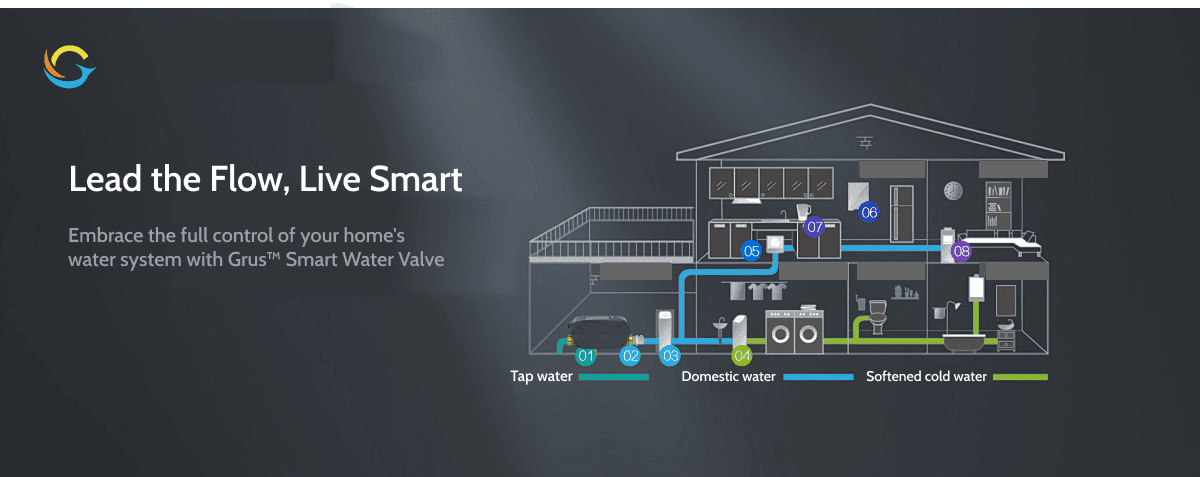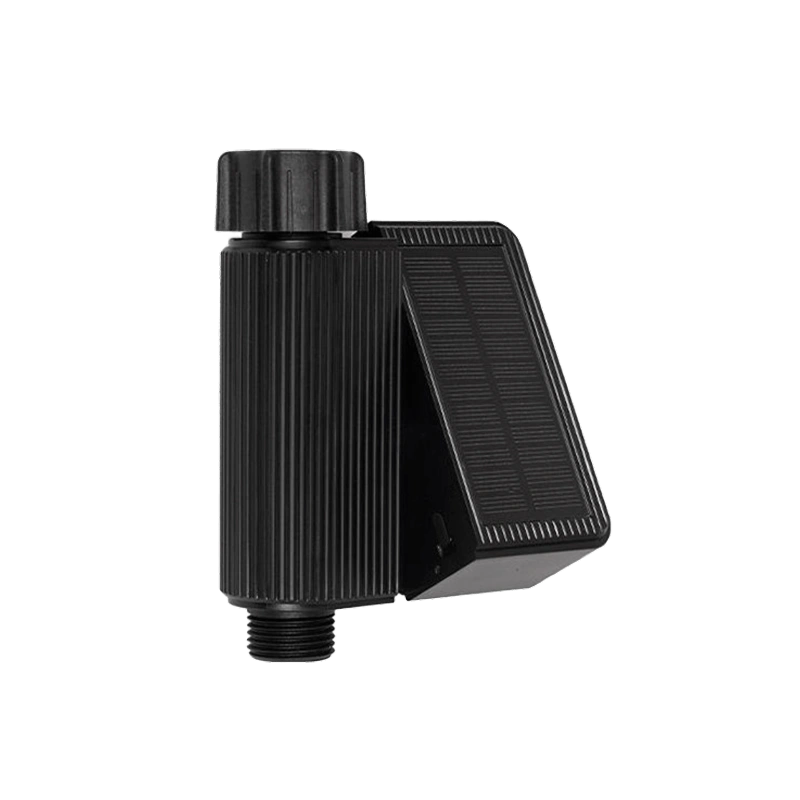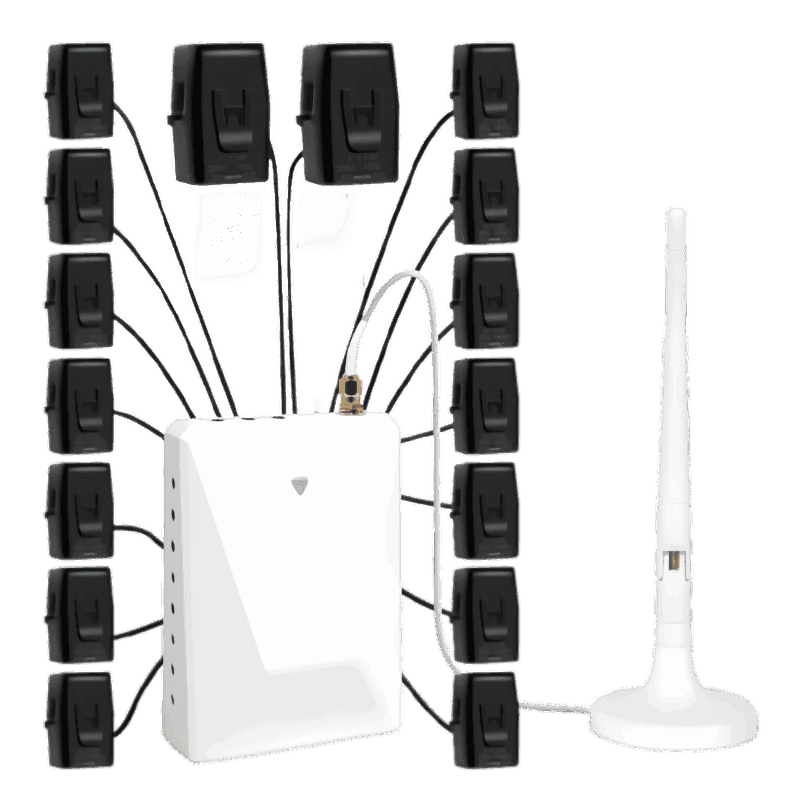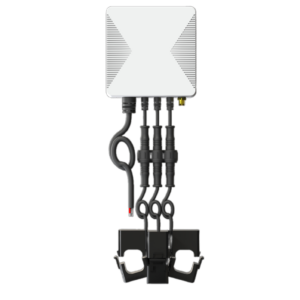When you see various videos and images of water damage online, it’s hard not to feel concerned. Even if you have the best plumbing installed in your home, there’s always a lingering worry—what if a leak happens while you're away at work? For those of us working the typical nine-to-five, the fear of coming home to a flooded house, or worse, causing damage to your downstairs or adjacent neighbors, is real. Wouldn't it be great if your home's water system could automatically shut off while you're at work? This would significantly reduce the risk of leaks and give you peace of mind.
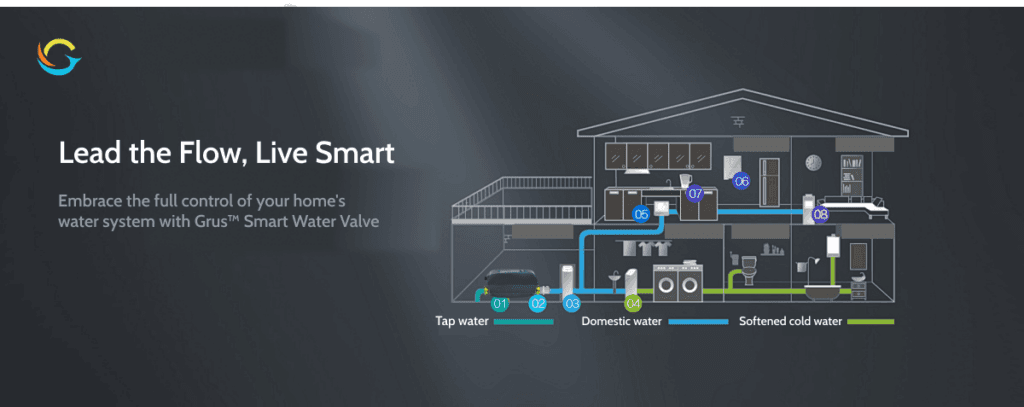
This is no longer just wishful thinking. The advent of smart water valves has made it possible to prevent such disasters. These devices offer precise monitoring and real-time alerts, helping you stay ahead of potential issues. Whether you’re enjoying some personal time or tackling important tasks, your water system can operate autonomously—safely and efficiently.
1. Features and Benefits
Remote Control and Automation
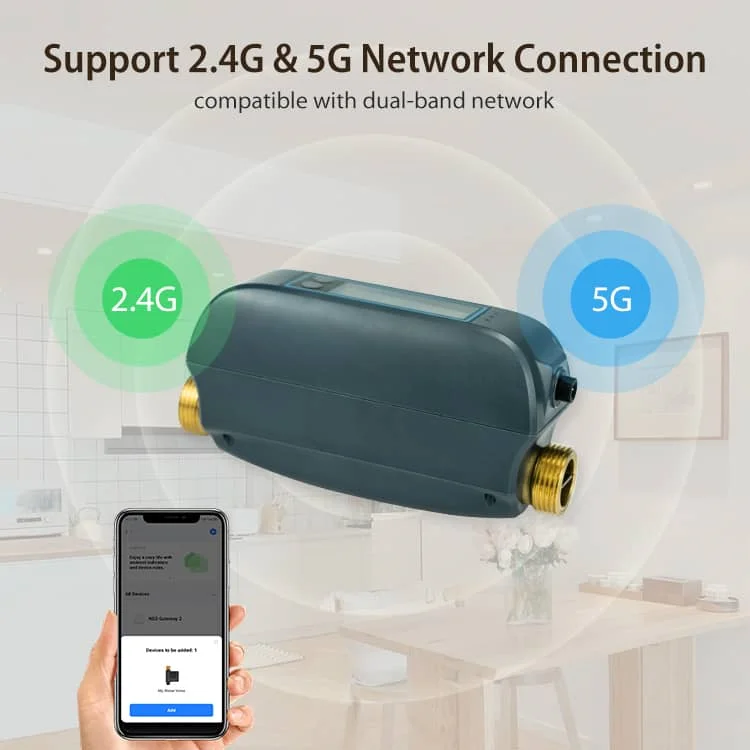
Smart water valves and meters can be controlled remotely via Wi-Fi or Zigbee, among other wireless network protocols. These devices typically integrate with home automation platforms like Amazon Alexa, Google Home, or dedicated mobile apps. Users can turn off or on their water supply from anywhere in the world using a smartphone. For instance, the AquaNet-BD smart water valve supports remote shutoff operations, ensuring that your water supply is turned off even if you’re thousands of miles away, effectively preventing water damage.
- Data Transmission Speed: Smart water valves generally use 2.4GHz Wi-Fi for data transmission, ensuring a stable signal connection. Remote commands typically respond within seconds.
- Automation Scenarios: Integrated with smart home systems, users can set up conditional triggers, such as automatically shutting off the water valve when a leak is detected or adjusting irrigation schedules based on the weather.
Leak Detection and Alerts
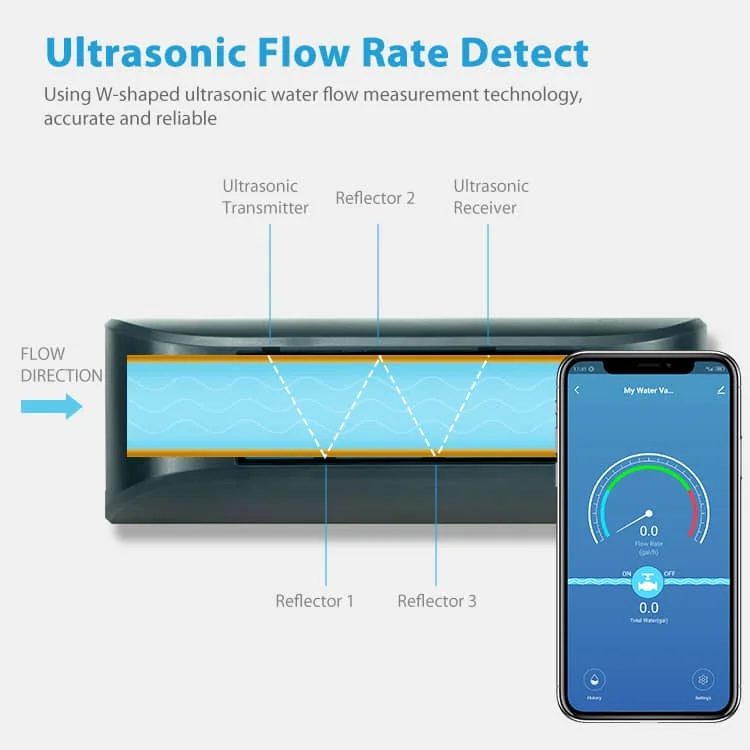
Smart water valves are equipped with highly sensitive flow and pressure sensors that can detect even the slightest irregularities in water flow. When a leak or pipe burst is detected, the system immediately sends an alert to the user and automatically shuts off the water supply. For example, the AquaNet-BD’s flow sensor boasts a detection accuracy of ±1%, allowing it to identify subtle changes in water flow.
- Flow Detection Accuracy: Smart water valves’ flow sensors can typically detect flow changes as low as 0.1 liters per minute, ensuring that leaks are detected at the earliest stage.
- Alert System: Based on user-defined thresholds, the system sends notifications to the user’s phone when the flow exceeds the set limits. The AquaNet-BD supports a wide range of threshold settings, which can be flexibly configured to meet different household needs.
Water Resource Management and Conservation
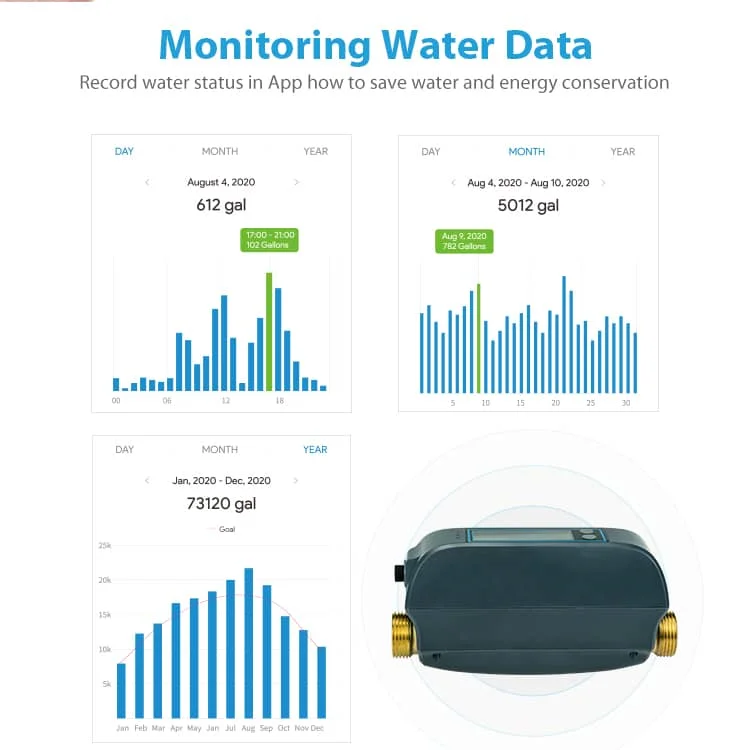
Smart water meters provide precise measurements of water usage, sending data to a mobile app so users can monitor their consumption in real-time. By setting limits or alerts, users can reduce unnecessary water usage, helping households manage water resources more effectively and avoid waste. For instance, the AquaNet-BD can generate reports based on daily, weekly, or monthly water usage, helping users identify peak usage periods and take appropriate measures.
- Water Usage Data Statistics: Smart water meters can provide detailed daily, weekly, and monthly usage data, with an accuracy usually within ±1%.
- Water-Saving Mode: Some smart water valves feature a water-saving mode that adjusts water pressure or limits the maximum flow to reduce waste. The AquaNet-BD’s water-saving mode can automatically adjust based on real-time data, potentially saving 10%-30% of water resources.
2. Practical Usage Scenarios
Home Safety
Smart water valves are particularly useful for preventing water damage. For example, a leak incident while you're away from home could cause severe damage. Traditional water valves can’t automatically shut off the water supply when unattended, whereas smart water valves can prevent such accidents through real-time monitoring and automatic shutoff. The AquaNet-BD, when paired with the high-sensitivity AquaNet-M leak sensor, can respond instantly to a leak, ensuring home safety.
- Response Time: Smart water valves typically shut off within 1-2 seconds, significantly reducing potential water damage.
- Applicable Areas: Suitable for areas prone to leaks, such as kitchens, bathrooms, or basements.
Remote Monitoring and Control
For households with multiple properties or rental units, the remote control feature of smart water valves is invaluable. Users can check the real-time water usage at each property through a mobile app and shut off the water supply if necessary. This not only prevents accidents caused by tenants but also helps owners manage water resources during property vacancies.
- Multi-Location Management: The AquaNet-BD supports multi-location control, allowing users to manage multiple smart water valves from a single app and monitor water usage in real-time at each property.
- Historical Data Review: The system can save historical water usage data for each location and provide graphical analysis, helping users make informed management decisions.
3. Installation and Maintenance
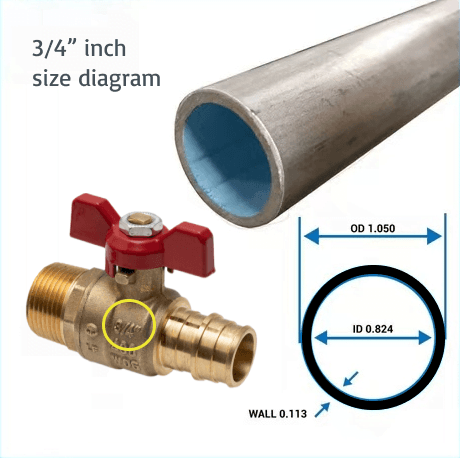
Ease of Installation
Smart water valves are generally easy to install, with many products designed for plug-and-play use, requiring no professional assistance. The AquaNet-BD supports standard 3/4-inch pipe interfaces, compatible with most existing household plumbing systems. The product packaging includes a detailed installation guide and video tutorials.
- Compatibility: The AquaNet-BD is compatible with most existing household plumbing systems, including common PVC, PPR, and copper pipes.
- Installation Time: Typically, users can complete the installation within 30 minutes.
Maintenance and Durability
Smart water valves are usually designed for long-term use. The AquaNet-BD is made from high-strength brass or stainless steel, capable of withstanding long-term water pressure and various environmental conditions. The product is equipped with waterproof and dustproof designs, ensuring normal operation even in harsh conditions. Additionally, the device has a self-check function that sends notifications in case of malfunctions.
- Material: The AquaNet-BD’s brass material offers excellent corrosion resistance and high-temperature performance, suitable for various water quality environments.
- Lifespan: Designed to last over 10 years, requiring only periodic checks of the connection parts with minimal maintenance.
4. Cost and Return on Investment
Price and Cost-Effectiveness
Smart water valves typically range from $100 to $300, depending on the brand and features. Although the initial investment may seem high, considering the water-saving and leak prevention features, a smart water valve can save users substantial amounts in water bills and potential repair costs in the long run. For example, the AquaNet-BD is priced at $129, but its smart water-saving and leak prevention features could save users hundreds of dollars annually in water bills and repair costs.
- Savings Calculation: Assuming a user’s monthly water usage is 3,000 gallons, a smart water valve can help reduce usage by 5%-10%, saving about $5-$10 per month on water bills, or $60-$120 per year. Additionally, avoiding a single leak incident’s potential damage could far exceed the product's purchase cost.
5. Power Consumption Monitoring and Measurement Methods
Power Consumption Monitoring
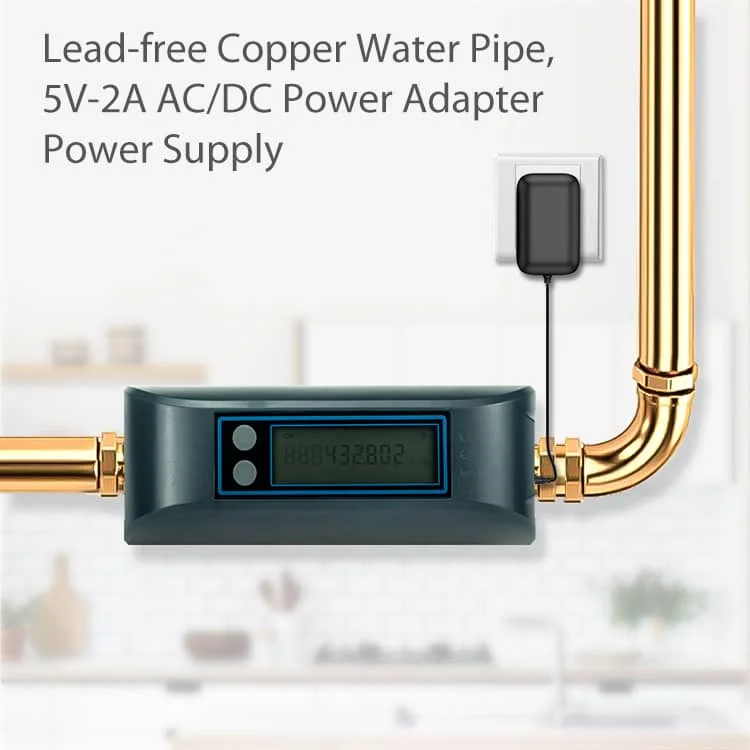
Modern smart water valves typically require household electrical power and can monitor their own power consumption. These devices generally use low-power designs, with an average annual power consumption of 5-10 kWh. The AquaNet-BD also supports continued operation during power outages via a built-in battery, ensuring the device can perform critical functions in emergencies.
- Power Consumption: The AquaNet-BD’s standby power consumption is 1 watt, and it consumes 5 watts at full load. Even with long-term operation, the impact on household electricity bills is negligible.
- Emergency Power: The built-in 1000mAh lithium battery can keep the system running for up to 72 hours during a power outage.
6. Popular Products Comparison
The detailed introduction above covered the various functions, practical applications, installation and maintenance details, and economic benefits of smart water valves. Hopefully, this information has helped you better understand and evaluate the advantages of smart water valves in managing household water usage. However, there are many different brands and models of smart water valves on the market, each with its own unique features, installation methods, and detection accuracy. To help you choose the right smart water valve for your household needs, we’ve compared several popular smart water valves in detail.
Here’s a comparison table of some popular smart water valves on the market:
| Product Name | Key Features | Connectivity | Leak Detection | Remote Control | Smart Home Compatibility | Installation Difficulty | Battery Life/Power Source | Market Price (USD) | Unique Advantages |
|---|---|---|---|---|---|---|---|---|---|
| AquaNet-BD | Remote flow control, leak detection, auto shutoff | Wi-Fi/Bluetooth | 0.1 liters/min | Mobile app, voice control | Alexa, Google Home | Easy, DIY installation | Low-power battery/AC adapter | $150-$180 | High-precision leak detection, low power consumption, compatible with various smart home systems |
| Moen Flo | Real-time flow monitoring, leak detection, auto shutoff | Wi-Fi | 0.1 gallons/min (~0.38 liters) | Mobile app, voice control | Alexa, Google Home | Requires professional installation | Battery/AC power | $400-$500 | Professional-grade leak detection, high price reflects high precision and quality |
| Phyn Plus | Real-time flow monitoring, leak detection, auto shutoff | Wi-Fi | 0.1 liters/min | Mobile app, voice control | Alexa, Google Home | Moderate, may require professional assistance | Battery/AC power | $500-$700 | Offers advanced analytics and automatic diagnostics features, but at a higher cost |
| LeakSmart | Instant leak detection, automatic shutoff, smart home integration | Zigbee, Wi-Fi | 0.25 liters/min (~0.06 gallons) | Mobile app, voice control | Alexa, Google Home, Samsung SmartThings | Easy, DIY installation | Battery/AC power | $200-$250 | Fast response time, wide compatibility with smart home systems, slightly higher detection threshold |
| Guardian by Elexa | Instant leak detection, automatic shutoff, water usage monitoring | Wi-Fi | 0.2 liters/min | Mobile app, voice control | Alexa, Google Home | Easy, DIY installation | Battery/AC power | $250-$300 | Solid all-around features, a good middle-ground option in terms of price and functionality |
Recommendations:
- For Budget-Conscious Users: The AquaNet-BD offers a balanced mix of essential features and affordability, making it an excellent choice for most households.
- For High-End Users: The Phyn Plus offers advanced features, including detailed analytics, but comes at a higher cost, making it more suitable for those looking for premium performance.
- For DIY Enthusiasts: The LeakSmart is relatively easy to install and offers good compatibility with smart home systems, making it ideal for users who enjoy setting up their own smart home solutions.
In conclusion, choosing the right smart water valve depends on your specific needs, budget, and level of comfort with technology. Whether you want basic leak protection or advanced analytics, there’s a smart water valve that can help protect your home from water damage and save you money in the long run.
